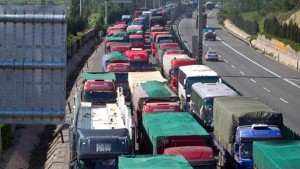
A days-long traffic jam on the G-110 toll road into Beijing underscored the perils of China becoming a nation on wheels.
The People’s Republic of China faces a huge dilemma when it comes to cars.
On the one hand the swift rise of the Chinese automobile industry has brought jobs, investment and a huge measure of prestige to China over the past decade. Only last month, the Shanghai Auto Show eclipsed the New York Auto Show by attracting senior executives from Daimler AG, Toyota and Volkswagen, among others. China’s hunger for new vehicles probably won’t peak for another decade, according to most estimates.
China is now the world’s largest automotive market, surpassing the United States and is unlikely to slip back into second place, noted Columbia University economics professor Jeffrey Sachs during a panel discussion at the International Transport Forum in Leipzig, Germany.
However, Gao Honfeng, China’s vice minister of transport, told that same forum that China is acutely aware of the environmental and other hazards posed by the rapid development of its automotive culture.
There’s been a significant price tag for putting the nation on wheels: most notably in the form of paralyzing traffic jams, choking smog and a costly dependence upon foreign sources of energy.
Both Beijing and Shanghai, two of the primary centers of China’s automotive boom, have major congestion and pollution problems, Gao acknowledged. The Chinese government is doing what it can to encourage people to use mass transit by making it more efficient, Gao said during a panel discussion sponsored by the ITF.
The government also is attempting to put some brakes on car sales by making licensing more difficult and more expensive – placing limits on the number of new vehicle registrations available in Beijing each month, for example.
Seven hundred million Chinese already use the busses and China is rapidly, adding more busses to increase the number of riders to 1 billion in the next few years.
The investment in mass transit isn’t only in Beijing and Shanghai, he added. In all, China also has built more than 1,000 kilometers of underground railways in cities all across China, dwarfing the subway construction in every other country in the world.
Sachs, who was on the panel with Gao, said the expansion of transportation networks is critical to economic growth. But at the same time, the automobile poses significant problems for city planners and government policy makers, who have to cope with the parking, pollution, congestion and sprawl created by the automobile. Light-duty vehicles running on petroleum become even more problematic as “conventional” oil, or oil that’s relatively easy to recover, becomes scarce, said Sachs.
“I wouldn’t recommend the American model where we are so dependent on cars to anyone” in the developing world, said Sachs, noting it consumes enormous amounts of land and other resources.
Gao said the Chinese aren’t all that interested in duplicating the U.S. model where there is virtually one car for every American. Such vehicle density isn’t really practical in China, he said. But in rural China, where one half of China’s population lives, better roads and better vehicles help foster economic growth and development.
In fact, General Motors, through its Wuling brand, has become China’s largest automaker by appealing directly to customers in China’s rural areas. The maker has just added a second brand, Baojun, that also targets buyers in smaller cities and rural areas.
China probably can learn from European countries, with their well -planned and well -integrated transit systems that utilize everything from trains to bicycles to help people navigate the urban landscape.
More efficient rapid or mass transit could help moderate the demand for automobiles in China’s big cities, said Gao, who also was in charge of China’s civil aviation agency during the rapid growth of the country’s airline industry, before taking over as vice minister of transportation.
However, people are “pluralistic,” Gao noted. They want efficient transit and they don’t like congestion but they also want to use their own automobiles, he said. “China used to be a nation of bicycles and it worked well,” he said through an interpreter. “But people have now taken to the car. I can’t ever see us going back to bicycles,” said Gao.
The question for China’s government now, he added, is how it can manage and plan for growth in a world where consumers won’t abandon the automobile.
